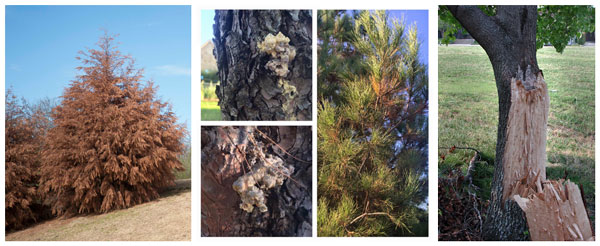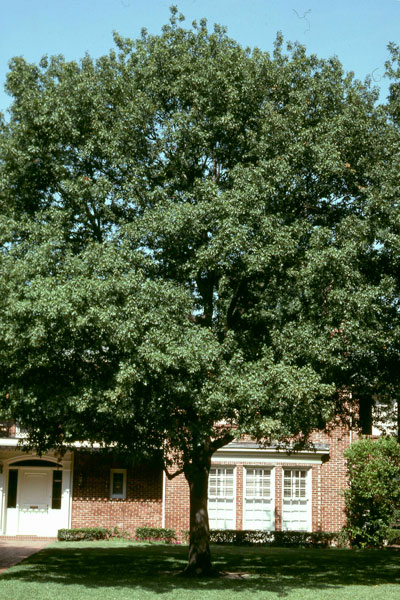My Favorite Shade Tree (and why!)
I have 55 years in Texas horticulture. And I’ve made some dreadful mistakes, as we all have. I recommended and planted Arizona ash and fruitless mulberries when they were both new in the market. I loved and planted Bradford pears, Leyland cypress and Eldarica pines when they were relative newcomers. Lots of people did. I planted willows and mimosas, and now it takes a real man to admit it.

Hall of Shame trees (L to R) Leyland cypress, Eldarica pines, Bradford pear. Click to see a larger photo.
So when I tell you that I have one tree that has stood the test of time (centuries, not just part of this one guy’s life) – one tree that, to my eye, stands head and shoulders above all the rest, it’s a tree I’m proud to recommend almost every day of the year. But keep reading just a little bit longer!
What I expect from my shade trees:
These are the criteria against which I measure all my tree candidates.
• Attractive. I don’t want any ugly-dog loser if it’s going to be the biggest plant at my place. This comes first.
• Adapted to what I can provide for it. Skip the big shade trees that have to be pampered, please. The tree I select has to be able to thrive in the climate and soils I have for it.
• No pest problems. It’s expensive and cumbersome to spray a large shade tree. The large shade tree that I’m going to choose can’t have serious issues with insects and diseases.
• Good form and strong branches. Some of our Texas trees are funny looking. And brittle. Or both.
• Longevity. I want a tree that I can plant with a grandchild, and know that he or she will be able to bring grandchildren to its base and recount the day that we planted it together.
Some people might want to include:
• Fast growth. Oh, please, please don’t go there! Fast growth means weak wood, which in turn means susceptibility to insects and diseases and breakage in ice and wind. No thanks!
• Spring flowers or fall color. OK. I’ll accept those, but they certainly aren’t at the top of my list of requirements, because they both last only a couple of weeks. That leaves me with too many months when the trees aren’t blooming or fall-colorful. These are bonuses. They shouldn’t be requirements.
And so my personal choice is…
I’ve said it for all of my career: “If I could have only one tree at the head of my grave, I hope it could be a Shumard red oak.

Shumard red oaks grow to be 50 or 60 feet tall and wide, so they qualify for the category of “large shade trees.” Their large, deep green foliage during the growing season is outstanding, and fall color many years is vibrant. Other than a few harmless insect galls, Shumard red oaks rarely have issues with pests.

Don’t get me wrong. Other oaks are also great choices, as are cedar elms, pecans and even non-native Chinese pistachios, but for one reason or another, Shumard red oaks rise just slightly above them in my own personal preferences.
The one warning I’ll give you about red oaks (and chinquapin oaks, also Chinese pistachios) would be to protect their thin bark from sun scald and subsequent invasion by borers the first couple of years after you plant them. Wrap their trunks with paper tree wrap from the nursery or hardware store. Start at the ground line and wrap them as soon as you plant them, and let them grow to shade their trunks. You’ll also discourage woodpeckers in the process.
There you have it. Neil has a favorite, and its name is “Shumard.”
